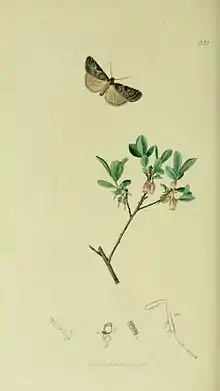| Stilbia anomala | |
|---|---|
 | |
| Scientific classification | |
| Domain: | Eukaryota |
| Kingdom: | Animalia |
| Phylum: | Arthropoda |
| Class: | Insecta |
| Order: | Lepidoptera |
| Superfamily: | Noctuoidea |
| Family: | Noctuidae |
| Genus: | Stilbia |
| Species: | S. anomala |
| Binomial name | |
| Stilbia anomala (Haworth, 1812) | |
| Synonyms | |
| |
Stilbia anomala, the false footman or anomalous, is a moth of the family Noctuidae. It is found in parts of western Europe.
Technical description and variation
The wingspan is 29–36 mm. Forewing grey, shining; the costa suffused with dark fuscous; inner and outer lines double, blackish, filled in with whitish, irregularly dentate; subterminal pale with suffusedly darker edges; orbicular and reniform stigmata with pale annuli externally dark margined, separated by a diffuse dark shade, the former oblique and narrow; hindwing white tinged with brown along termen; in the female the forewing is more uniformly blackish fuscous; — the form philopalis Grasl.[now species Stilbia philopalis (Graslin, 1852)], from S. E. France, is smaller, paler, with the markings showing up more prominently; - andalusica Stgr. [now species Stilbia andalusiaca Staudinger, [1892]], a Spanish form, is also smaller than the typical, but with less distinct lines and markings; — in syriaca Stgr., [now species Stilbia syriaca Staudinger, 1892] from Asia Minor, the wings are broader, the hindwing as well being much darker; calberlae Failla-Ted.[now species Stilbia calberlae (Failla-Tedaldi, 1890)] , from Sicily, is certainly a good aberration: the males are blacker in forewing than the darkest female of the typical form, with the hindwing brightly white. [1]

Biology
Adults are on wing from August to September.
Larva green to pale brown; dorsal and subdorsal lines yellowish white, with dark margins;spiracular whitish, with the upper edge grey. The larvae feed on various grasses, including Deschampsia flexuosa.[2]
References
- ↑ Seitz, A. Ed., 1914 Die Großschmetterlinge der Erde, Verlag Alfred Kernen, Stuttgart Band 3: Abt. 1, Die Großschmetterlinge des palaearktischen Faunengebietes, Die palaearktischen eulenartigen Nachtfalter, 1914
- ↑ "Robinson, G. S., P. R. Ackery, I. J. Kitching, G. W. Beccaloni & L. M. Hernández, 2010. HOSTS - A Database of the World's Lepidopteran Hostplants. Natural History Museum, London".
External links